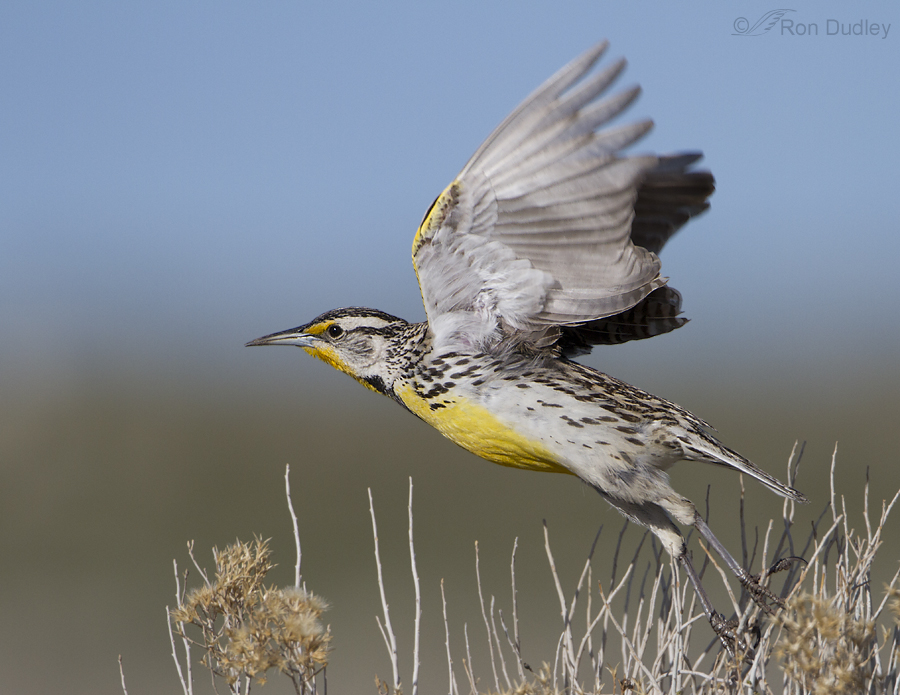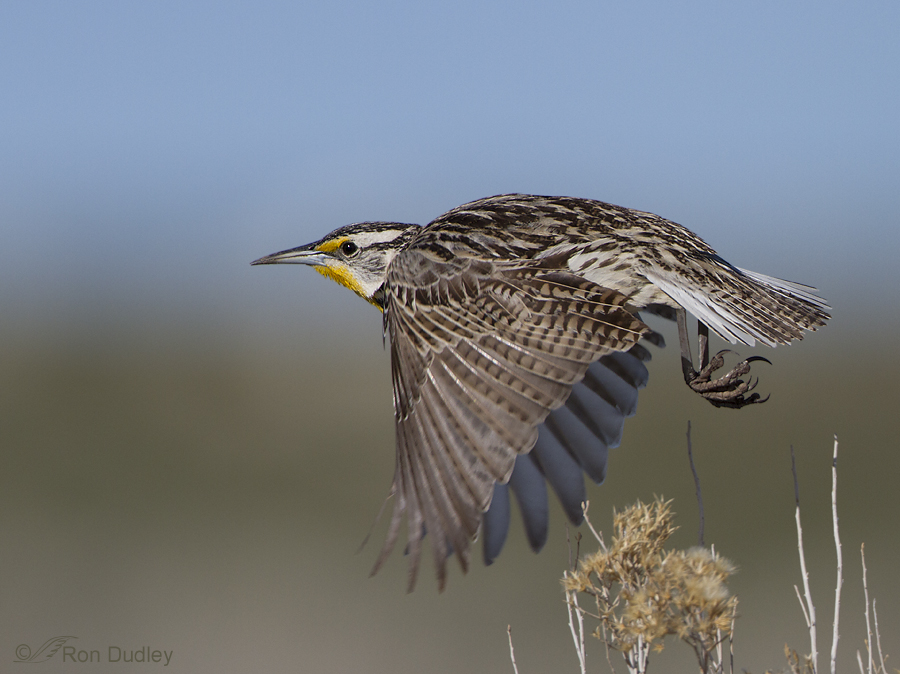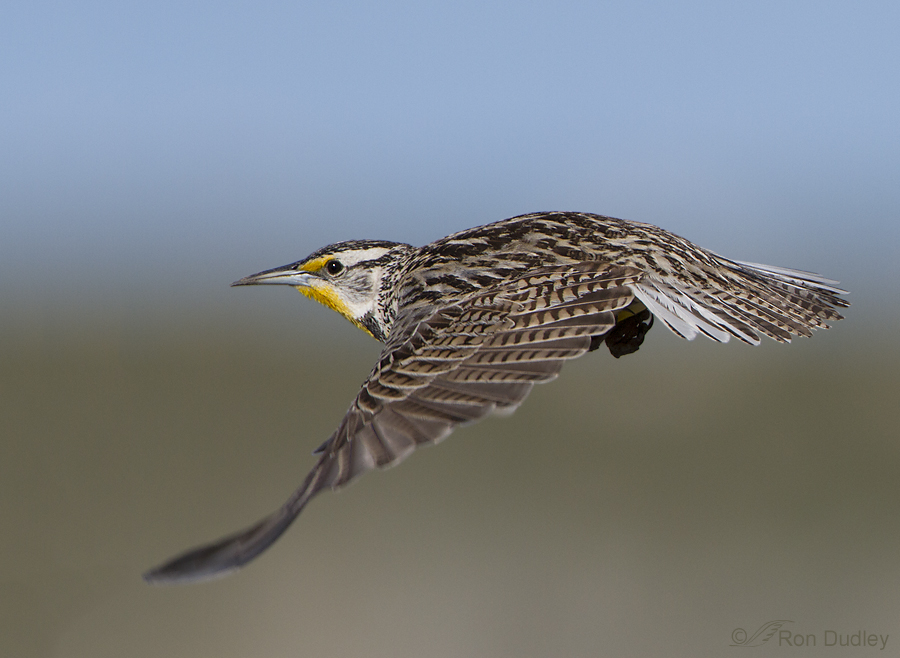Yesterday morning there was meadowlark magic on the island. They were almost everywhere, singing lustily from atop their sagebrush and rabbitbrush perches (and more than a few ugly signposts). Several times I just stopped the truck, turned the engine off and went outside to listen. You could hear dozens of them simultaneously – some very close, some far away and others everywhere in between. Their melodious calls literally bounced off the hilltops.
And I even got close enough to a few of them to get some images I like.
1/3200, f/6.3, ISO 640, 500 f/4, 1.4 tc, natural light
This was one of them and it sang for us for some time. But I also wanted take-off shots so I made sure I had what I thought was enough shutter speed and waited for that explosive take-off, hoping I’d had enough coffee that morning to kick in my reflexes sufficiently.
Take-off shots of small birds are infinitely more difficult than they are of larger ones like most raptors and waders. Smaller birds launch much more quickly, their wings move faster, their direction of take off is more unpredictable and they can (and do) turn away from you on a dime. I have many nice shots of raptors taking off but my files are sadly lacking similar images of songbirds. So I keep trying. And trying…
1/4000, f/6.3, ISO 640, 500 f/4, 1.4 tc, natural light
This time I got lucky. The bird launched at an angle that worked, I had good light and I caught the wings up. Notice that even 1/4000 second shutter speed didn’t completely freeze the wings (I’m pretty sure that depth of field didn’t cause the wingtip blur). Readers sometimes ask why I use such high shutter speeds so often. A big part of the reason is because I’m regularly after these kinds of shots. These little birds move fast!
I’m happy as a lark (sorry…) if I can get a single image in a burst that works when a small bird takes off but this time…
1/4000, f/6.3, ISO 640, 500 f/4, 1.4 tc, natural light
the next one was a keeper too – this time with the wings down.
And lo and behold…
1/4000, f/6.3, ISO 640, 500 f/4, 1.4 tc, natural light
the third image in the burst was one I liked also! For me it’s unheard of to get three decent take-off shots of a small bird in the same sequence. True, the bird was a little past me but I’m not complaining.
I was pretty close to this meadowlark for take-off shots (these are not large crops) and I’m amazed that I didn’t clip anything in any of them, though I did have to add canvas for composition to this last image.
One of my “meadowlark goals” (probably a pie in the sky pipe dream) is to photograph one of these birds singing on the back or horns of a bison. Lots of birds such as starlings, cowbirds and magpies regularly perch on bison. And meadowlarks are ubiquitous on the island and seemingly not fussy about their perch. The problem is, I’ve never seen one on a bison – even from a distance. Perhaps meadowlarks don’t like living, breathing, pooping, moving perches.
Maybe it’ll happen one day. If it ever does, you’ll know…
Ron






Wow. Keeping an eye on those settings and working on it.Thank you for sharing these top-notch shots.
Wow, fantastic job, Ron! I sure know how hard such shots can be! You should be very pleased.
Great shots! And how heavenly it must have sounded to hear all of them sing. I am envious, both of your images and your songbird experience.
All that singing was heavenly, Susan. Quite the experience.
Meadowlark magic sums this up perfectly. Megathanks.
Thank you, Elephant’s Child.
Dang! This is one of those times when I appreciate the quality of the image more than the bird itself! lol
I love birds and really gloss over most of the technical info on how Ron got the shot (for fear of learning something
I guess) But these are the kind of images that make me say “how’d he do that?”…..to learn more about it, guess
I’ll have to give up some 5th grade math to make room in ma noggin.
Tim
I got a kick out of your comment, Tim. I include some of that technical stuff because there’s a fair number of photogs following my blog. Hope I don’t overdo it sometimes.
Thank you for these spirited shots of one of may favorite birds. I love their songs in the morning and throughout the rest of the day. They seem to be able to throw their voices somehow, since very often when I look up they are not where I think they should be. We have had flocks of them lately but they seem to be dispersing now, getting ready to nest. These and the mountain bluebirds really sing up a show for us this time of year. Last year we had mockingbirds in Teasdale on our property for the first time. I am wondering if they will return…..global warming?
I agree about their apparent ventriloquist skills, Tana. I really envy you your Mountain Bluebirds. There’s a few of them not too far from here but whenever I’m in your general Teasdale area there seems to be lots of them. My best success with them has been in sw Montana.
Beautiful shots!!
Thanks, Susan.
Wonderful marvelous shots Ron! These are fantastic birds that I have never been able to get close enough to to take a decent shot! Thanks so much for sharing your expert shots. They brightened my gray day!
Charlotte
Thanks, Charlotte. They’re usually hard for me to approach too but there’s so many of them on the island that occaionally one of them forgets to fly off when I get close.
I hope you know that your photos are the “light of my life!” Thanks so much for sharing them.
Charlotte
Great photos! I especially like the gradient in the background of the blue sky and the green trees.
Thank you, Sam. I like that gradient also.
Ron, help me out here.
You are spot on with these Meadowlarks, obviously focused on the eye(s).
But, when the bird flies How do you stay on the bird when it takes off and moves so fast????
Are you throwing away many shots?
Man, when I’m taking pictures of birds flying or just taking off, I’m throwing away many more shots than I keep.
It’s almost like I have to wait till they land to get a halfway decent image. Maybe I just have to boost the speed?
Absolutely, Dick – most shots in situations like this are garbage. Too many things can go wrong and they usually do (Murphy and his damned law, ya’ know…)
First off, you need plenty of shutter speed – the smaller the bird the faster your SS should be (my goal is 1/3200 minimum for the little guys but then I generally prefer “frozen” wings). Then you have to hope they’ll take off laterally to you. Flying toward you sometimes works but not often. Away from you is a butt shot. Hopefully I’ve maneuvered myself so the sun is behind me.
Maintaining focus is a crap shoot. Sometimes I use AF and hope I can keep it on the bird (4 center AF points selected) when it launches and other times I prefocus on the perched bird, don’t use AF, and hope the bird stays in the same plane when it takes off as it was when it was perched.
With my Canon 7D I’m nearly always shooting at ISO 500 or 640 (800 if I have to) for take-offs to hopefully give me enough SS and DOF.
And quick reflexes in a situation like this are a given. My finger is always on the shutter button, partially depressed and waiting for take-off. You really need to concentrate!
Hope this was helpful. Good luck!
Very helpful, Many Thanks!!
Your right Ron, BUT, at least you can see them, many times I can only hear them!! (G)
Great shots truly admirable. I love the action
Thanks very much, Thomas.
God, I love your up close and personal shots! Fantastic!!
Obviously, there is something to be said for having wide open spaces and not tons of trees in the way! (G)
Dick, You’re probably right. Fewer trees means fewer cluttered backgrounds but it also means fewer birds (on average) because there’s a lot less cover out here.